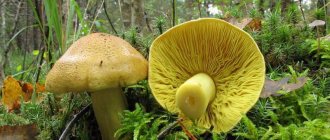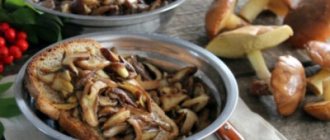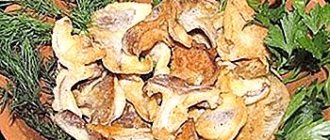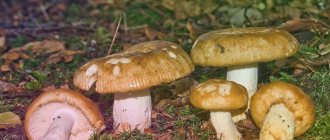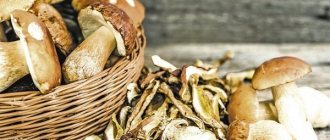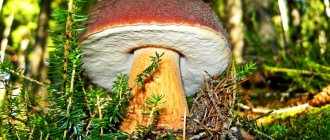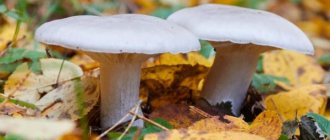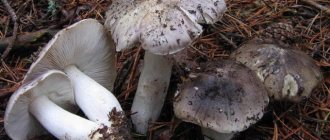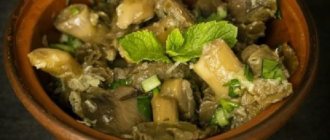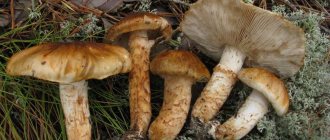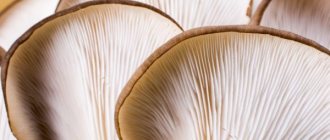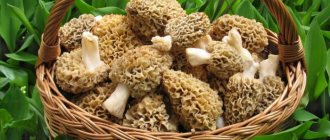3.8 / 5 ( 12 votes)
Blueleg is a common exotic mushroom that scares off many mushroom lovers with its color. Grows in groups in visible places. Mushroom growers value bluelegs for its excellent taste. They say that fried podotavniki taste like meat. Due to its dense structure, the blue leg practically does not shrink after cooking.
Description of the lilac-legged row + photo
Experienced mushroom pickers always consider three main features of the bluelegs that are responsible for edibility:
1) the presence of pink plates on the back of the cap; 2) color scheme in lilac-violet tones; 3) a captivating fruity aroma, which distinguishes the mushroom from many poisonous mushrooms.
But even if the mushroom meets all three parameters, it would not be superfluous to check the remaining characteristics and compare it with similar and false species.
hat
Reaches in size from 4 to 17-18 cm. It is considered large, noticeable from afar. In comparison with other members of the family, it has thick, dense flesh that does not lose elasticity even after heat treatment. In real reviews left on forums and social networking groups dedicated to growing and collecting mushrooms, one can find clear examples of “overgrowth” reaching 28 and even 30 cm.
Fruiting is observed in groups. It is not surprising that sometimes there are overripe mushrooms that can cover a growing family with their caps. A unique ability that keeps young purple-footed rows small, ideal for pickling and pickling in the winter. The small size reduces cutting time, increasing the chances of a seamless preservation.
The shape of the cap is flat, resembling a thick pancake. When young, the edges are slightly bent, but gradually straighten over time. In most cases they are colored yellow-violet.
To avoid getting your hands dirty from the sticky layer that has become slimy after rain, it is recommended to use gloves during collection and cleaning. The trick will prevent your fingers from getting dirty, eliminating the washing process.
Leg
The most unusual and striking thing about bluelegs is the leg, or rather its color. The skin is colored lilac or deep purple. At a young age, the shade is a little lighter, but with age it becomes expressive, attracting attention to your person. It is quite rare to find individual specimens whose legs are close to blue.
The mushroom is not tall. The length reaches 6-13 cm and does not exceed the cap. The diameter is medium, no more than 2.5-4 cm.
At a young age, the leg has a fibrous coating, which over time becomes smooth, resembling silk. Outwardly, it often seems that the lower part is straight, but if you look at the base more closely, you will find that there is a small cone.
Controversy
It reproduces by spores produced by adult mushrooms on the lamellar layer. The color of the spore powder is yellowish-pink, repeating the outline of reduced ellipses. The arrangement of the plates is close, differing in color. Only sprouted bluelegs have snow-white plates, and those that are older are soft pink and even brown.
Pulp
When cut, the mushroom has snow-white flesh with a slight shade of purple. It is distinguished by good density and the presence of a heady aroma of fruits grown in the summer. Thanks to this feature, purple-legged rower is often used as an ingredient for preparing cold appetizers and hot salads.
False doubles
The violet row, despite its unusual color and appearance, has doubles, which are worth knowing about when going into the forest. Even experienced silent hunters can confuse this species. To correctly distinguish the variety, you should pay attention to the photo or study the table.
| Name of the mushroom | Differences | Places of growth | Edibility |
| Lepista lilac (bluefoot), Lepista saeva | Light, almost snow-white hat, purple leg. It is often called false violet row. | Zones with a subtropical climate. It grows from mid-winter until the first frost. | Conditionally edible |
| Violet lepista, Lepista irina | The mushroom is characterized by a whitish or pinkish-brown shade of the cap. In the center it is much darker than at the edges. This part is convex, with an uneven edge. The pulp has a bright violet color, which does not go away even after careful heat treatment. | Dense forest stands of temperate climate. Growing time: September – second half of November. | Conditionally edible |
| Lilac varnish, Laccaria amethystina | It has more miniature parameters, the diameter of the cap is only 5 cm. In young specimens it is convex, then becomes flatter. The leg is thin and even, it has a bright, uniform purple hue, but with age it fades and becomes paler. The pulp is also brightly colored, purple, and uniform in color. | Wet soils of the temperate climate zone. It grows from the second half of June until late autumn. | Conditionally edible |
| Purple web spider, Cortinarius violaceus | The cap is convex, with curled edges, or lowered and straight in adulthood. It has a brownish or slightly purple tint, evenly distributed throughout the fruiting body. The plates are sparse, dark purple in color. The pulp has the same color, but as the mushroom ages, it may fade. | Deciduous and coniferous forests, grows in early August - second half of September. | Conditionally edible, listed in the Red Book. |
| White-purple web spider, Cortinarius alboviolaceus | Round-bell-shaped or convex cap with an uneven surface. Its diameter is 4–8 cm. The stem is thin, up to 8 cm. The color of the mushroom is lilac-silver, pale lilac. The pulp is thick, soft, and watery in the stem. Has a characteristic musty odor. | Forests in temperate climate zones, growing time - late August - October. | Inedible |
| Goat's web spider, Cortinarius traganus | A hemispherical hat with rolled edges. Its diameter is 6–12 cm. The leg is thick and short, about 7–10 cm long, and has a bright violet-gray tint. The pulp is thick and has a strong unpleasant odor that does not disappear even after heat treatment. | Coniferous and mixed forests of temperate climate. Grows from July to early October. | Poisonous |
| Mycena pure, Mycena pura | Compared to the purple row, it is more miniature. The cap is wide-conical, hemispherical, its diameter is 4 cm, the stem is thin, up to 9 cm in height. The color is pale grayish, the edges are translucent, with stripes. The pulp is thin and watery, gray in color, and when broken it releases a lot of liquid. The fungus has a strong, unpleasant odor. | Temperate forests. It grows from early spring until the second half of July. | Inedible |
Where does it grow and at what time?
You can find rowing in almost any region of Russia, regardless of climatic conditions. Fruiting begins in cool weather, when the heat gives way to high humidity and moderately cold nights. You can start collecting from mid-September, continuing the search in October and November until frost replaces frost.
The distribution of mycelium is predominantly in light, unplanted areas. Forest belts, edges, boundaries of forests and reservoirs, meadows and fields are ideal options for searching for edible prey.
Mushroom pickers living away from the city can try their luck near a farm and cattle pastures. The mushroom culture positively responds to fertile soils fertilized with manure, growing on their area in large quantities, forming full-fledged colonies or rows. Depending on the weather and the harvest of the previous year, fruiting may be fertile or, conversely, meager in volume.
The presence of crops in cold regions and areas with changeable weather can also be observed in the summer, subject to high humidity. Like other representatives of the mushroom world, the purple-legged row is 90% water, so it cannot develop normally in dry weather.
Many mushroom pickers manage to get a large harvest in a few months by preparing preserves for the winter and eating plenty of mushroom-based dishes: aromatic dietary soups, fried potatoes in rows, julienne, home-style roast, warm salads and even baked goods. Baked pies with mushroom filling are especially tasty when combined with overcooked chopped onions and grated carrots.
Important!
Beginning mushroom pickers should not pull out mushrooms, violating the integrity of the mycelium. It is better to do it the old fashioned way, cutting off the base with a knife.
As collection equipment, it is allowed to use not only buckets and baskets, but also deformable containers, which are: a bag, a backpack, a shopping bag and even a cardboard box.
Methods for preparing bluelegs
After collecting and transporting blue stem mushrooms, they need to be processed as quickly as possible. They need to be kept in salt water for some time to eliminate insects that may be in the mushrooms. Bluelegs should be cleaned first.
Then they need to be washed under running water, boiled for 15 minutes, and drained. After this, they can be used to prepare various dishes.
Pickled bluelegs
Bluelegs are often pickled. Mushrooms prepared in this way are truly a delicious product, as they have an unusual, pleasant taste.
To prepare pickled bluelegs, you need:
- Boil peeled mushrooms (1 kg) for 20 minutes.
- Place in a colander and wait until the water has completely drained from the mushrooms.
- Pour a liter of water over the blue legs, put on the fire, and bring to a boil.
- When the water boils, add 2 tablespoons of coarse salt, a few bay leaves, and 12 black peppercorns. Also, if available, you can add a few oak or currant leaves - they will add a special taste and aroma to the finished product.
- Boil mushrooms with spices for 10 minutes over low heat.
- Take 2 cloves of garlic, chop, add to the mushrooms along with two tablespoons of vinegar.
- Boil everything together for 7-10 minutes.
Pour the mushrooms and brine into sterilized jars, close, and place in a warm place until cool.
You can also prepare dishes from bluelegs for a full lunch or dinner - first course, second course, salads.
Bluefoot soup
To prepare the soup, you need to take 500 g of mushrooms, one chicken fillet, 3 potatoes and 2 onions, medium-sized carrots, one bell pepper. You will also need salt, ground black pepper, and bay leaf.
Bluelegs soup is prepared as follows:
- The mushrooms are cleaned, washed, and boiled in salted water for half an hour.
- The fillet is cut into small cubes.
- Vegetables are peeled and cut: onions into small cubes, potatoes into cubes, peppers into thin strips.
- Grate carrots.
- Fry the onion in oil until transparent, then add carrots to it and bring until golden brown.
- The liquid in which they were boiled is drained from the bluelegs and filled with new water, chicken and potatoes are added, and put on fire.
- Boil the soup for 20 minutes. Add fried vegetables and peppers 10 minutes before the end.
- Add salt and pepper, cook for a couple more minutes and turn off the heat.
This mushroom soup is especially good with sour cream and finely chopped herbs.
Mushrooms in batter
These unusual mushrooms also make a good tasty snack - bluelegs in batter. They are suitable for both a family dinner and a holiday table.
For this recipe you will need: kefir (0.5 l), flour (500 g), bluelegs (1 kg) and vegetable oil.
- Mushrooms need to be cleaned, washed, and separated from the stems.
- Next you need to prepare the batter. To do this, mix kefir with flour, mix well so that the mass becomes homogeneous, without lumps. Leave the batter for 10 minutes.
- Heat vegetable oil in a frying pan. Dip the bluelegs caps into the batter, making sure that it evenly covers them on all sides, then place them in oil and fry on both sides until golden brown.
You can eat mushrooms in batter both hot and cold. Fresh dill and parsley are ideal for them.
Bluefoot, or purple-legged rower, is a mushroom common in spacious meadows and in places where areas are enriched with humus. Although it is considered a conditionally edible mushroom, it can be eaten without fear after heat treatment. Bluelegs can be grown in your garden plot or in special premises.
Similar edible species
Before choosing a day for a trip to the forest, you should carefully study similar types of mushrooms that fall into the category of edible and false, unsuitable for consumption. The first is to collect and eat safely, following the rules for preparing the collected pulp before the main cooking.
- No. 1 – Violet row
It belongs to the category of conditionally edible mushrooms that require repeated boiling before eating. It is colored pinkish-white or brownish-red, depending on the age and size of the fruit. On the reverse side it has white or purple plates. The leg is light, in rare cases it has a pinkish tint. The aroma is floral. In size and fleshiness, they are almost identical to bluelegs.
- No. 2 - Purple cobweb
An edible mushroom with a frightening purple color. In rare cases, it has manifestations of blue and orange. Most often, red shades color the part of the leg hidden behind the cap.
- No. 3 – Purple row
Conventional mushroom of the Lepista genus, Govorushka family. In comparison with the purple-legged row, it has a rich shade of the cap, corresponding to the name. In most cases, there is an orange tint on the top of the head.
- No. 4 – Lilac varnish
It has several distinctive features from the blue leg, namely: snow-white spores, a fibrous leg, and a thin cap that is inferior in fleshiness.
Description, characteristics and category of mushroom
Bluefoot (scientific name Lepista saeva Lepista personata) belongs to the Ryadovkov family from the genus Lepista. It can also be called: Potatavnik, Lilac-footed row, Goose row, Lilac-legged row, Blue-legged, Sinyushka, Two-color row, Blue root.
Many people look at the blue leg with disbelief. Due to its unusual color, it is often considered poisonous and passed by. Like any other mushroom, the lilac-legged row has false doubles.
You can recognize the edible boletus mushroom by the following characteristics:
- The cap reaches a diameter of 6-10 cm and has a flat-convex shape. You can find a giant mushroom with a diameter of 25 cm.
- The top of the cap is smooth with yellowness and a slight purple tint. Inside this part the color is the same.
- The structure of young mushrooms is dense, and as they mature, it becomes looser.
- The hymenophore (lower part of the cap) consists of rare cream-colored plates.
- Spores are 7x5 µm, almost round, folded, veined, amyloid.
- The leg grows up to 10 cm. The base is slightly thickened. The leg is smooth with a blue tint.
- The smell of the row is not like a typical mushroom one. There is a sweetish aroma with fruity notes.
In Russia, the cost of rowing ranges from 150 to 300 rubles per kilogram. Pickled mushrooms in a three-liter jar cost from 1,500 rubles.
False mushrooms: inedible and poisonous
Particular care should be taken when collecting purple-legged row, so as not to accidentally or in a hurry collect mushrooms that are dangerous for consumption into the basket. Even a small piece used as food can cause poisoning of the body, disruption of the gastrointestinal tract and intoxication of the body.
- No. 1 - Goat's web
Repels mushroom pickers with an unpleasant odor comparable to the process of decay. There is not even a hint of fruity notes in the aroma that distinguish edible rows.
- No. 2 - White-purple cobweb
A distinctive feature remains the red inclusions on the main shades of the stem, raising doubts about edibility even among novice mushroom pickers.
Edible or not
Unfortunately, its attractive and at the same time intimidating appearance scares off most novice mushroom pickers due to concerns about edibility. Some even manage to push the family with their feet so as not to germinate next to the noble breeds. However, despite its underestimation, the lilac-legged or blue-footed row remains an edible mushroom with valuable nutritional properties that can replenish the daily requirement of an adult. Experienced lovers of quiet hunting quite often replace meat with their pulp, creating a varied daily diet during periods of dietary nutrition and Orthodox fasting.
The fourth category of edibility involves heat treatment, which consists of repeated boiling and draining of the broth.
Important!
Don’t be alarmed if the mushrooms change their color during cooking; this is a common feature.
Characteristic features of the variety
Blue leg, blue leg, two-colored row, blue leg row, purple leg row, or blue root - all these are names of the same mushroom. It received its names due to its color and unique location. After all, bluelegs grow in a row, tightly pressed against each other.
Appearance and photo
The lilac-legged row, which is the scientific name of the mushroom, is collected with pleasure by experienced mushroom pickers, because it is very tasty. Beginning mushroom pickers should familiarize themselves with the photo and carefully study the description of the mushroom so as not to confuse it with saprophytes, which under no circumstances should be eaten.
Lilac-legged rower
The bluefoot stands out with its shiny, rather dense cap, wrapped inward. This makes it resemble a round bun.
Structure and species differences
Let's look at what this view looks like in more detail. The cap usually reaches 10 cm in diameter, but there are also quite large ones - up to 25 cm. The color is light yellow, with a slight purple tint. It is important to note that color may vary. It depends on weather conditions, place of growth and age of the mushroom.
As already noted, the edges of the cap are rolled up, but in old fruits they may be turned inside out. The hat is slightly oily to the touch and sticky in rainy weather. The plates are located underneath it. They are most often yellowish in color, but can also be cream, pinkish-cream, or gray-cream. The plates themselves are large and freely arranged.
The legs are quite thick at the bottom (up to 3 cm), club-shaped, smooth. The length generally does not exceed 10 cm. The unusual bright purple, violet or gray-violet color and fibrous structure are the main differences between young mushrooms.
The flesh of the Blue Leg is of the same purple color. When characterizing it, one can also note the density and thickness of the structure. With age it becomes more loose. A very unusual aroma. Some mushroom pickers compare it to the aroma of pineapple.
Place of distribution, rules and conditions of collection
Bluelegs can be found almost throughout Russia (except for the Far North). They also grow in North and South America, Europe, and Kazakhstan.
Lilac-legged rowers love to settle in meadows and pastures. But they are not very fond of forests, preferring a lot of light. If they can be found there, it is only under deciduous trees. They also like places with organic fertilizer, such as compost pits and abandoned farms, peat and chernozem soils. You can also collect Blue Legs in forest ravines with rotten leaves.
They grow very close to each other, in whole families. Therefore, it is difficult not to notice them. There were cases when up to 20 kg of crops were harvested in one place. Experts recommend going “hunting” from April to October in dry weather. During the rainy season, the fruits are slimy and sticky, which makes them unpleasant to the touch, but they tolerate light frosts down to minus 5 degrees very well.
Note!
It is better not to take old fruits at all, or to know how to clean them properly. If this is not done, consuming them can lead to negative consequences, including poisoning.
Eating
The Blue Leg mushroom is conditionally edible, but despite this, it is very tasty and is somewhat reminiscent of champignons and even chicken. It is fried, salted, pickled, boiled, dried, that is, eaten in any form except raw.
Useful properties and restrictions on use
Blueleg is not only tasty, but also very healthy. It is perfect for those who watch their diet and count calories: 100 g of this product contains only 22 kcal. In addition, it contains many vitamins and minerals. That is why the lilac-legged rower is recommended to be consumed during the cold season.
Bluefoot improves the functioning of the heart and blood vessels, normalizes blood pressure, strengthens the immune system, has anticancer, antimicrobial and antibacterial effects, and has a beneficial effect on all organs. However, people suffering from chronic diseases of the gastrointestinal tract and liver should refrain from eating mushroom dishes.
Useful properties and contraindications
100 g of mushroom product contains no more than 22 kcal. The pulp is enriched with vitamins A, B, C, D, minerals and trace elements. In addition to high water content, the fruits contain fatty amino acids and proteins that replace the consumption of boiled meat. When used in cooking, a person receives stearic and glutamic acid, glucose, protein and trehalazole.
Consumption in small quantities promotes:
- strengthening the immune system;
- acceleration of metabolism;
- prevention of cancer and benign tumors;
- increasing the elasticity of the skin and slowing down aging;
- increasing endurance;
- strengthening the nervous system, heart and blood vessels.
Use is prohibited due to the presence of contraindications:
- pregnancy period, regardless of trimester;
- lactation;
- children's age up to 12-13 years;
- exacerbation of chronic gastrointestinal diseases, peptic ulcers;
- renal failure;
- individual intolerance;
- presence of an allergic reaction.
People suffering from diabetes or after a stroke or heart attack should use mushrooms with extreme caution.
Assessment of taste qualities, benefits and possible harm
When preparing and storing tits, it is important to remember that despite their external attractiveness, this is still a conditionally edible mushroom that can be poisoned if not prepared correctly.
Violet row contains a large amount of vitamins B1 and B2, manganese, zinc and copper. It also contains ergosterol (provitamin D2) and stearic acid. Calorie content of cyanosis - 19 kcal/100 g.
The medicinal properties of Lepista glabra are widely used in pharmaceuticals. Antibiotics and antifungal drugs are made from this species. The ability of violet row to reduce glucose levels is known, which is actively used for the manufacture of drugs to control hyperglycemia. Titmouse supports the immune system and has anti-inflammatory properties.
The harm of rowing lies in the possibility of confusing it with poisonous species. In addition, it is forbidden to consume mushrooms for children under 9 years of age, pregnant and lactating women, and people with diseases of the gastrointestinal tract.
Important! You cannot pick mushrooms near roads, highways, or near large enterprises. Fruiting bodies have the ability, like sponges, to absorb harmful microelements.
Cleaning and heat treatment
To properly prepare the collected bluelegs, preserving the fruity aroma characteristic of mushrooms, it is necessary to thoroughly clean, soak and boil.
1) After arriving from the forest, the mushrooms are sorted one by one, removing plates filled with spores and sand. The procedure allows the body to quickly digest the product without disrupting the gastrointestinal tract.
2) The next stage is removal of the leg. The lower part is not used in cooking, getting rid of excess weight even at the time of collecting edible prey. The trick allows you to save space to collect a larger volume of purple-legged row.
3) After complete cleaning, the mushrooms are soaked in a salted solution for 2-3 hours, checking every hour to ensure that the water remains cold.
4) Upon completion of the procedure, the caps are washed, placed in a deep boiler, and filled with water. Boil twice over low heat until boiling, draining the resulting broth and adding fresh water. During the final boiling, add a pinch of citric acid, which allows you to preserve the unusual shade, which raises not only your appetite, but also your mood.
5) The product, ready for further preparation, is thrown into a colander and washed. Finish the heat treatment by lightly drying it on a tray.
Interesting Facts
In order not to make a mistake in the forest during harvesting, you need to cut the mushroom, which looks like Lepasta glabra. If a distinct purple tint appears on the cut, then you have definitely found a purple row.
In some countries, all types of row mushrooms are considered poisonous mushrooms. But as experience shows, this species can be eaten after prolonged soaking and boiling.
Rowers got their name from their ability to grow in rows. Sometimes these fruiting bodies form entire circles, which are popularly called “witch circles.”
The unusual, beautiful mushroom Lepista violet undoubtedly deserves the attention of lovers of quiet hunting. However, we should not forget that this is a conditionally edible species and it is contraindicated to eat it raw. In addition, purple row requires repeated boiling. After carrying out all the necessary processes, you will receive a tasty, aromatic, beautiful dish.
How to fry purple-footed row, recipe step by step at home
Bluelegs can be prepared in different ways. Frying mushrooms can be either served as a separate dish or combined with potatoes, porridge, vegetables and berries. The choice in favor of the best option is given based on the taste preferences of the housewife and household members. For example, frying potatoes with mushrooms involves cooking two ingredients in different frying pans. Subsequently, the products are combined and served as a single dish with sweet and sour sauce and fresh vegetable salad.
I use vegetables and berries separately, as a dressing or refried. If you decide to cook a vegetable stew, the cook fry the mushrooms and vegetables separately, combining them into a single dish, as in the case of potatoes. If preference is given to berries, use only the juice, adding it as a dressing to the prepared dish.
For 1 frying pan, 350 g of purple stem row is enough to later combine with a side dish.
Easy lifehack!
Fried mushrooms can be placed on loaf slices, adding a slice of tomato and grated cheese to bake hot sandwiches in the oven.
Application
Edible russula are very popular in cooking and medicine. They are used to prepare delicious dishes and effective medicines.
Cooking
First, the russula is boiled in salted water: peeled, cut and poured with water so that it completely covers them.
Place on the fire, bring to a boil, skim off the resulting foam. You need to cook for 15 minutes, then add salt and spices. Cook for the same amount of time, remove from heat, strain and the boiled mushrooms can be used to prepare any dish.
Pickling
These mushrooms are very fragile and break quickly, so they are not suitable for drying. But they are readily salted, and the product is not only tasty, but also healthy.
():
Russulas for pickling need to be properly prepared. And this means:
- All fruiting bodies must be sorted by size and color.
- Throw away any spoiled mushrooms. Attention! Russulas need to be handled very carefully due to their fragility.
- After sorting, the mushrooms must be washed and cleaned: if they are very dirty, they can be soaked for several hours in cold water. Or pour boiling water and after the water cools, catch the mushrooms, which will become stronger.
- Mushrooms must be rinsed with running water.
- It is better to remove the skin from the caps (this will improve the appearance and increase the shelf life of the finished product).
You can pickle it in small jars - 1-2 liters. For cooking you will need 4 tbsp. l. coarse salt per 1 kg of mushrooms. Mushrooms boiled according to the method described above are placed in jars, each layer is sprinkled with salt and any spices. Be sure to add bay leaf - it will give the pickling a good aroma. The workpiece is covered with a nylon lid and placed for a month in a cool and dark place (cellar, basement). After time, it is ready to eat.
They marinate in the same way, only boiled mushrooms are poured with a pre-prepared marinade - 200 ml of vinegar 9% and 100 g of table salt are dissolved in 1 liter of water.
Frying
Fried bruises are very tasty. They are served both separately and as a side dish for fish and meat.
You can cook using different methods, but you need to adhere to a simple rule - the frying time should not exceed 20 minutes, otherwise they will disintegrate and their taste will not be rich.
By the way. Experienced mushroom pickers advise cleaning russulas with bright blue and red caps before frying so that they do not give a bitter aftertaste when cooking and spoil the dish.
Marinating bluelegs, secrets
Like any mushrooms of the fourth category, the purple-legged row is pickled after heat treatment is completed. In comparison with other representatives of its species, its properties do not allow it to boil over, turning into a mushy mass.
Recipes for cooking at home provide step-by-step instructions with one of the technologies to choose from. Today, two options for marinating are offered: hot and cold. The choice in favor of the best solution is left to the housewife, who calculates the possibilities and duration of storage.
Is it possible to salt and ferment
The fourth category of mushrooms is not suitable for pickling and fermentation, as it does not have the characteristic mushroom taste necessary to combine with crunch. Culinary experts advise preferring the classic marinating method to avoid getting into the trap of high expectations.
The lilac-legged rower, popularly called the blue-legged mushroom, has a description and photo that allows you to distinguish the edible mushroom from similar and false species. There are plenty of recipes for cooking at home, which will surely appeal to lovers of a varied diet.
